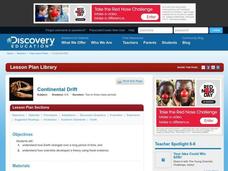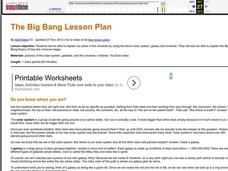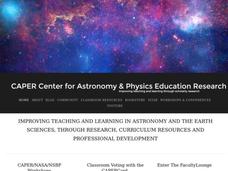Curated OER
Astronomical Scales
Students describe the different units of measurement. In this space science lesson, students calculate astronomical distances using a scale. They explain the significance of using scientific notation in expressing very small or very...
Curated OER
The Great Hubble
Students explain how Hubble telescope captures images from space. In this space science lesson, students use the internet to view space photos. They debate on an issue raised by the teacher.
University of Wisconsin
Rain Garden Maintenance
Maintaining a garden is an ongoing responsibility. This resource follows a series of activities in a unit that resulted in the planting of a rain garden. What you will find here are general instructions for watering, weeding, pruning,...
Curated OER
Let's Go Fly a Kite
Students complete activities to learn about wind. In this wind lesson, students study wind in an open field and use a kite to complete their observations. Students make a series of drawings to show how they flew their kites and explain...
California Academy of Science
Measuring Earthquakes
After a brief discussion on earthquakes, make a makeshift seismograph to record the shaking of the table that it sits upon. While the background information will be useful to you as a teacher, the seismograph does not seem like it would...
Curated OER
Weightlessness
Students use a coffee cup to demonstrate weightlessness. After a lecture/demo, students read an article on free-fall. They perform a simple experiment which helps them explain the concept of weightlessness.
Curated OER
People and Space
Students eat dehydrated foods that the astronauts would eat in space. In this dehydrated foods lesson plan, students make lists of food they could eat, discuss how dehydration takes place, eat food, and complete discussion questions.
Curated OER
Biomes: Islands and Evolution
Students discover how islands form, how plant and animal species get there and what the term means. In this biomes lesson students prepare a presentation that describes the life forms and geography of an island.
Curated OER
Astronomy
Students explore the rotation of the Earth and observe the shapes of constellations. After discussing how the Earth moves. volunteers use a flashlight and globe to model the movement of the sun-Earth system. Using Digitalis technology,...
Curated OER
Living Fossils
Students study the term living fossil and examine why some of the reasons they survived. For this fossils lesson students form a hypothesis and use data to see if it is accurate.
Curated OER
Testing the Caverns
Students build model caverns using paper mache or clay and bury them in a tray of sand. They test the models by dropping balls onto them to simulate an asteroid hitting the earth. They evaluate the effectiveness of a structure against...
Curated OER
Constellations
Middle schoolers explore the major constellations. After reviewing the Earth's basic motions and their significance, students discuss the moon's orbit and revolutions. Using a Digitarium Alpha portable planetarium projector, they...
Curated OER
Phases of the Moon Flipbook
Third graders create a flipbook. In this phases of the moon lesson, 3rd graders examine how the moon changes and phases occur. Students create their own flipbook of the phases of the moon using file cards to create a motion-picture effect.
Curated OER
The Ice Age
Students study the ice age and the causes of it. In this Ice Age lesson plan students examine why those animals became extinct and complete activity sheets.
Curated OER
Continental Drift
Be sure to come prepared to discuss the theory of Pangaea and the two super-continents, Laurasia and Gondwanaland. Collaborative learners look for fossil evidence that supports the theory that one super-continent divided into two. They...
Curated OER
Solstice and Equinox
Students identify the dates of the solstices and equinoxes and how they relate to the various seasons on Earth. After discussing how the solstice and equinox affect the seasons, students use their bodies to demonstrate the how each...
Curated OER
Shadows All Around Us
Students create shadows. In this shadow casting lesson plan, students read books about shadows, view a demonstration on shadow casting and then practice shadow casting on their own. Students cast a shadow using the position of the sun.
Curated OER
The Big Bang
Learners explore our universe. For this solar system lesson, students gain knowledge about the solar system, galaxy, the universe and the Big Bang Theory. Learners watch videos and view a slideshow.
Curated OER
Astrology: Fact or Fiction?
Students explore the topic of astrology and review the beliefs behind it. They read sample horoscopes. Using a portable digital planetarium, they view the night sky and the zodiac constellations. They examine and discuss the science...
Curated OER
Continents Adrift
Students examine how tectonic plates change the Earth's land. In this geology lesson, students are divided into small groups to construct a continent puzzle. Students use transparency pieces to demonstrate how Africa and South America...
Curated OER
Reef Attack
Students identify the locations of coral reefs. In this oceanography instructional activity, students use the Coral Reefs website to locate the coral reefs on a world map and discuss ways to help protect the coral reefs.
Curated OER
Creating The Blueprints
High schoolers engage in a lesson in order to create blueprints to design an original floorplan. They use graphing paper and drawing tools to demonstrate knowledge of the lesson objectives. Students label and use the right kind of...
Curated OER
The Big One
Eighth graders study earthquakes. In this earthquake lesson students research the Internet on earthquakes and plot earthquake locations.
Curated OER
The Expanding Universe
Students explore the expanding universe. In this science lesson, students use balloons to model the expansion of the universe. Students take measurements of the balloon expansion and answer questions directed to develop their...

























